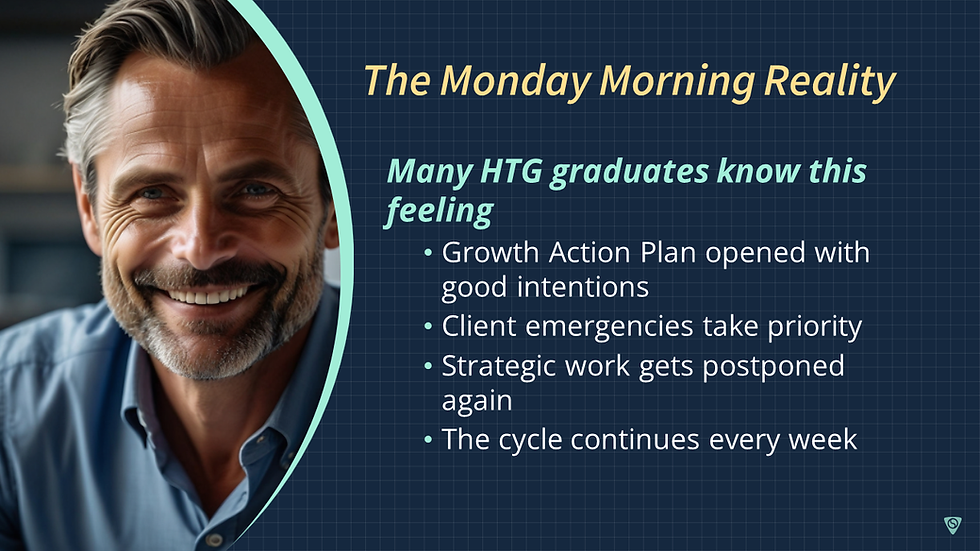The Monday Morning Reality: Why HTG Graduates Struggle with Sales & Marketing Implementation
- Simon Hale

- Aug 8, 2025
- 3 min read
Updated: Aug 12, 2025

Why having brilliant marketing strategy doesn't guarantee systematic business development
You know that feeling.
Monday morning arrives, and you open your Growth Action Plan with genuine determination. "This week I'm finally going to focus on my sales and marketing implementation."
The strategy is clear. The customer segmentation makes sense. You know exactly what you should be doing to generate leads and build your pipeline systematically.
Then your phone buzzes.
Client email marked "urgent." A proposal deadline you'd forgotten about. That "quick question" that somehow takes two hours to answer properly. The client who "just needs five minutes" for something that definitely isn't a five-minute conversation.
By Tuesday afternoon, you're deep in client delivery mode. By Friday, you've done excellent work for your clients, solved problems, delivered results they're delighted with.
But that Growth Action Plan? Still sitting unopened since Monday morning.
The Pattern Every HTG Graduate Recognises
If this scenario sounds familiar, you're in excellent company. Having worked with Help to Grow graduates across different industries, I see the same pattern repeatedly:
What you have:
Excellent strategic frameworks from your HTG programme ✓
Clear understanding of marketing strategy principles ✓
Comprehensive Growth Action Plans with detailed customer segmentation ✓
Professional expertise that your clients value highly ✓
What you're missing:
Sales and marketing implementation that actually fits around client work ✗
Systems that work WITH your business rhythm, not against it ✗
Practical approaches designed for busy business owners ✗
The frustration is real because the gap isn't about your capability or knowledge. You understand customer segmentation better than most business owners. You know the difference between marketing strategy and tactics. You've got frameworks that make perfect strategic sense.
The challenge is that brilliant strategy and systematic implementation are completely different skills.
Why Your Growth Action Plan Feels Impossible to Implement
Most Growth Action Plans—even excellent ones from HTG—make three assumptions that don't match your business reality:
Assumption 1: You Have Dedicated Strategy Time
Your Growth Action Plan was developed when you had focused thinking time, probably during HTG sessions or dedicated planning periods. It assumes you'll continue to have regular blocks of uninterrupted time for strategic sales and marketing work.
Reality check: When did you last have two uninterrupted hours for strategic thinking during a normal business week?
Assumption 2: Business Development Can Be Scheduled
Strategic plans treat sales and marketing activities like appointments you can book and keep. "Tuesday morning: work on lead generation. Thursday afternoon: develop content strategy."
Reality check: Client emergencies don't respect your strategic planning schedule. When a client needs something urgent, guess what gets postponed?
Assumption 3: Implementation Energy Is Unlimited
Your Growth Action Plan was created when you were energised about strategic possibilities. It assumes you'll maintain that same energy and motivation consistently, week after week.
Reality check: After a day of complex client delivery, how much mental energy do you have left for creating content, networking, or developing sales processes?
The Real Problem (And It's Not What You Think)
The real problem isn't:
Lack of strategic knowledge (you've got that)
Poor time management (you manage client work excellently)
Insufficient motivation (you want to grow your business)
Inadequate planning (your Growth Action Plan is comprehensive)
The real problem is this:
You're trying to implement strategic plans designed for ideal conditions within the constraints of running a real business.
What Successful HTG Graduates Do Differently
The HTG graduates who successfully implement their sales and marketing strategies don't have more time, better systems, or fewer client demands than you do.
What they have is implementation approaches designed for their reality.
Here's what that looks like:
They Start Small, Not Comprehensive Instead of trying to implement their entire marketing strategy, they focus on 2-3 specific areas that will create the biggest impact with their available capacity.
They Use Integration, Not Separation Instead of treating sales and marketing as separate from client work, they find ways to integrate business development with activities they're already doing.
They Design Around Energy, Not Just Time Instead of forcing strategic work into whatever time is available, they match sales and marketing activities to their energy patterns and working preferences.
The Monday Morning Solution
Here's what I've learned from working with HTG graduates who've successfully bridged this gap: you don't need to find more time for sales and marketing implementation.
You need to work differently with the time you have.
The question isn't whether you can find more time for sales and marketing. The question is: What would change if you designed your sales and marketing implementation around your actual business constraints instead of fighting against them?
Ready to bridge the strategy-implementation gap? Get your free 90-Day HTG Sales & Marketing Implementation Starter Guide
Comments